Guide to Choosing Motorcycle, ATV, and Powersports Batteries
In the dynamic and demanding realm of Powersports, the choice of battery significantly influences the performance and reliability of motorcycles, ATVs, and other high-demand vehicles. This comprehensive exploration into the world of motorcycle and Powersports batteries digs into the nuances of battery types, specifications, and the influential considerations required for making informed decisions. From considering the physical dimensions and capacity of various battery models to the intricacies of voltage requirements and cold cranking amps (CCA), this article offers a detailed guide that caters to the specific needs of diverse Powersports applications. It explores several key areas, including the selection of batteries based on detailed cross-reference guides, the impact of battery technology on performance, and the importance of maintenance strategies to enhance battery life. Additionally, we will discuss the implications of choosing the right battery about vehicle compatibility, environmental conditions, and personal riding styles, ensuring optimal functionality and longevity.
Catalog
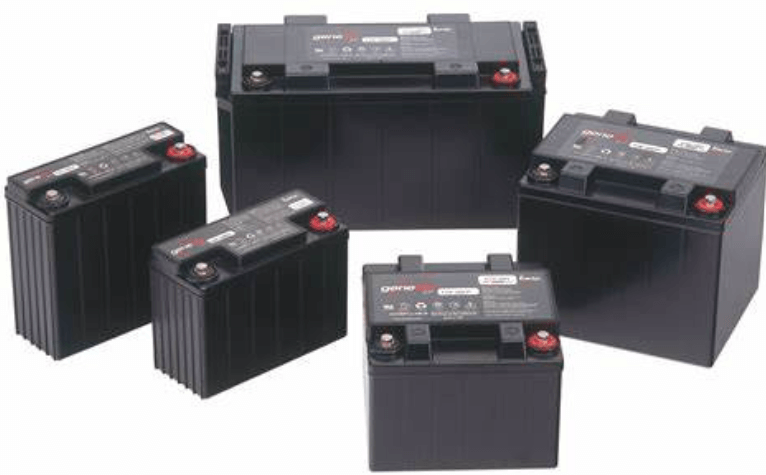
Figure 1: Motorcycle and Powersports Battery
Popular Battery Sizes for Motorcycles and Powersports
In the specialized field of Powersports, which includes ATVs and motorcycles, selecting the right battery requires a detailed look at the specifications of different models. Key models like YTX9-BS, YTX12-BS, YTX14AH-BS, YTX14-BS, and YTX20L-BS differ mainly in their dimensions, 10-hour capacity (Cap.), and cold cranking amps (CCA). These metrics are influential for evaluating the battery's starting power and performance under various conditions.
For example, the dimensions of these batteries range from 5.875 x 3.4375 x 4.125 inches for the YTX9-BS to 6.875 x 3.4375 x 6.125 inches for the YTX20L-BS. This range accommodates different sizes and power needs of various vehicles, ensuring compatibility and adequate power for each specific motorcycle or ATV. Well-known brands such as Chrome, Deka, EverLast, and Yuasa offer these models, each with unique capacities and CCAs to meet diverse consumer requirements.
Comparing these specifications is very significant. For instance, a YTX14-BS battery from Expert Power may have a 10-hour capacity of 220Ah and a CCA of 200, suitable for vehicles needing a high-power reserve. On the other hand, a similar model from Moto Batt might have different specifications that better match other needs. Thus, comprehensive comparison charts and detailed model analyses are required for riders and enthusiasts who want to optimize the performance and reliability of their vehicles' batteries.
Cross Reference for Powersports, ATV, and Motorcycle Batteries
A detailed cross-reference guide simplifies the process of selecting Powersports, ATV, and motorcycle batteries. This guide lists each battery's standard size and provides significant specifications like dimensions, voltage, and polarity, which are influential for matching batteries to different vehicle models. For example, battery models such as 12N24-3 and 12N5.5-3B vary in size from 7.25 x 4.9375 x 6.875 inches to 5.3125 x 2.375 x 5.125 inches, fitting different spatial requirements in vehicle compartments.
Considering these details helps avoid common mistakes, like choosing a battery that fits the space but doesn't meet the vehicle's electrical needs, or vice versa. The guide also highlights the benefits of advanced battery technologies such as sealed AGM (Absorbent Glass Mat) or Gel-cell batteries. These advanced options offer increased safety and lower maintenance compared to traditional wet/flooded batteries, as they don't require water addition and have reduced leakage risks.
In practical terms, a cross-reference chart is required not only as a buying aid but also as a strategic decision-making tool. It ensures that the selected battery provides the needed power and durability for demanding Powersports activities, supporting both performance and maintenance needs.

Figure 2: Odyssey Extreme Series Batteries
Odyssey Extreme Series Batteries
The Odyssey Extreme Series batteries are top-tier choices for high-performance needs in Powersports, ATVs, and motorcycles. These batteries are known for their rugged construction and ability to withstand harsh conditions, making them ideal for adventurous riders. The series offers a range of power capacities, from the PC310 with 310 PHCA to the robust PC1200 delivering 1200 PHCA, ensuring an option for every high-demand vehicle.
These batteries may require adjustments for compatibility due to their non-standard sizes compared to traditional battery compartments and cable setups. However, their durability and performance often make these setup challenges worthwhile. For instance, the PC680 model, with compact dimensions of 7.27 x 3.11 x 7.55 inches, provides 520 CCA and a 16Ah capacity over 10 hours. This makes it an excellent choice for demanding applications where performance cannot be compromised.
Choosing an Odyssey battery, despite the higher cost, ensures reliability and long-term value, especially in professional or extreme usage contexts where battery failure is not an option. Their proven performance in automotive, marine, and industrial environments underscores their superior quality and ability to operate under significant stress.
Why Do Powersports, ATV, and Motorcycle Lead-Acid Batteries Fail?
Considering and addressing the causes of early battery failure in Powersports vehicles is settling for extending their lifespan and enhancing performance. Key factors that shorten battery life include excessive vibration, mechanical shocks, and improper charging methods—conditions common in the rugged environments where these vehicles are used.
Older vehicle models are particularly susceptible to battery stress due to outdated charging systems. These systems often use a basic diode-bridge configuration that poorly manages voltage fluctuations, leading to overcharging and quicker battery wear. In addition, high ambient temperatures accelerate battery deterioration, making it dominant to store vehicles in cooler, shaded areas to prolong battery life.
The continuous use of onboard electronics, such as radios and GPS systems, also drains batteries, especially when the vehicles are idle. To mitigate these issues, implement preventative measures such as regular battery inspections, using proper charging devices, and maintaining optimal charge levels. These strategies ensure readiness and extend battery health.
Different Types of Motorcycle Batteries
Choosing the right battery—flooded, AGM, or lithium—is useful for motorcycle enthusiasts. Each type offers unique benefits and maintenance needs.
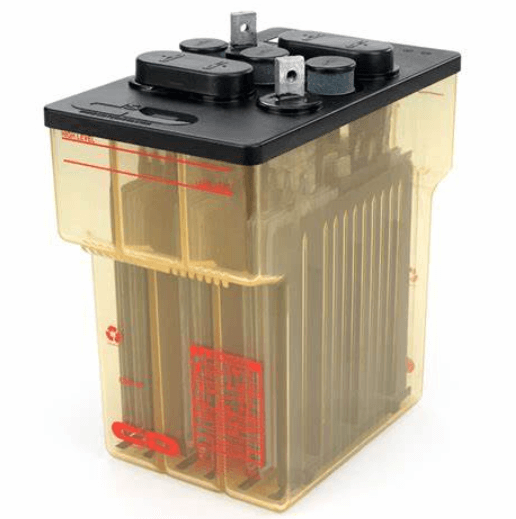
Figure 3: Flooded Batteries
Flooded batteries are cost-effective but require regular water top-ups to keep the battery plates covered. If the plates are exposed, sulfation can occur, reducing the battery's capacity. This type demands more frequent attention but remains a budget-friendly option.
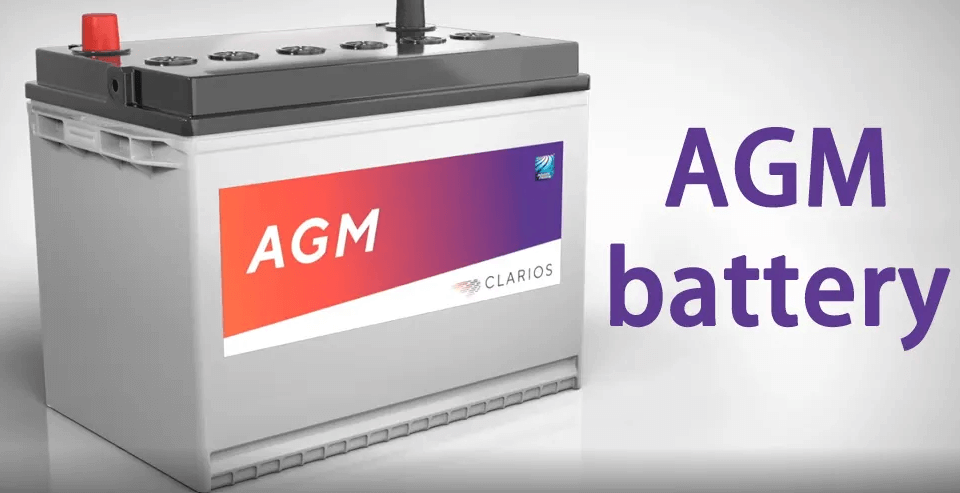
Figure 4: AGM (Absorbent Glass Mat) Batteries
AGM batteries have the electrolyte absorbed in glass mats, which makes them more resistant to vibration and eliminates the need for water refills. They provide a nearly maintenance-free experience and are ideal for those who prefer a set-and-forget solution.

Figure 5: Lithium Batteries
Lithium batteries are the latest in battery technology, offering significant weight savings and excellent charge retention. These batteries are perfect for high-performance enthusiasts looking for minimal maintenance. Although they are more expensive initially, their longevity and efficiency can lead to long-term savings.
Choosing the Perfect Battery Size for Your ATV or Quad
Selecting the right battery for an ATV or quad involves considering specific criteria such as voltage and cold cranking amps (CCA), which are required for reliable starting power in various conditions.
Voltage and CCA are for ensuring that the battery can start the vehicle reliably, even in cold or challenging environments. High CCA is particularly dominant for ATVs used in extreme conditions, as it provides the needed power to start the engine effectively.
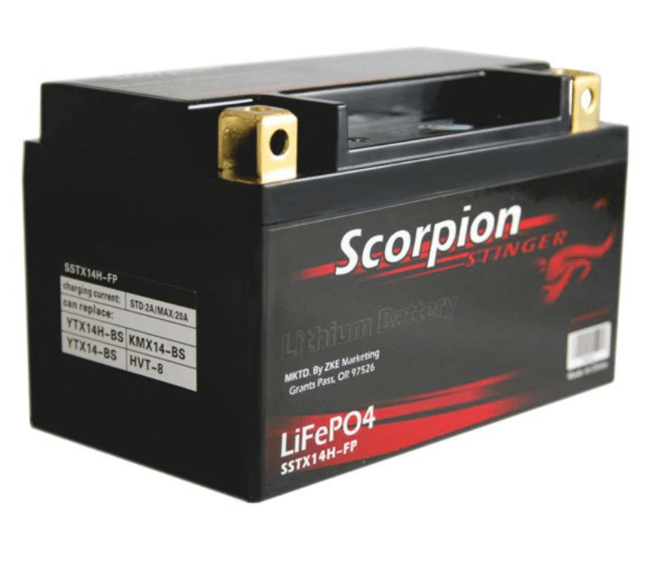
Figure 6: Scorpion Batteries
Scorpion batteries are designed to meet these standards, offering high CCA to ensure dependable starts. They are known for their reliability and broad compatibility with many vehicle models, making them a popular choice among ATV manufacturers like Honda and Yamaha.
Scorpion batteries adhere to high manufacturing standards, which is why they are trusted by leading ATV brands. Their widespread use in global markets underscores their adaptability and robustness. Choosing a powerful and versatile battery like Scorpion ensures that your ATV or quad performs optimally, meeting the diverse needs of its users.
Tips for Motorcycle Battery Care and Maintenance
Maintaining motorcycle batteries effectively requires more than just routine charging. Each battery type has specific needs that must be addressed for optimal performance.
For flooded batteries, regular inspection and topping up of water levels are insistent. This prevents the battery plates from being exposed, which can lead to sulfation and significantly degrade performance.
AGM and lithium batteries need to be kept clean and dry. Ensuring that the terminals are free from corrosion is particularly dominant for these types of batteries.
Using the appropriate charger and following the manufacturer's guidelines for charging and storage are required. Adhering to these recommendations not only extends the battery's lifespan but also enhances its performance. Implementing preventive measures is key to preserving battery functionality. For instance, maintaining the battery at a 50% charge during long periods of inactivity can prevent degradation.
How to Choose the Right Motorcycle Battery?
Selecting the right battery for your motorcycle is required to maintain top performance and reliability. This guide will help you make an informed choice, focusing on the settling specifications and practical aspects of motorcycle batteries.
|
|
Description |
|
Considering Battery Specifications |
First, determine your motorcycle's
voltage requirement. This ensures your battery has the correct electrical
potential to function properly. Next, look at the Cranking Amps (CA) and Cold
Cranking Amps (CCA). CA measures the battery's ability to start the engine in
normal conditions, while CCA measures its efficiency in cold weather. The CCA
rating is particularly noteworthy for riders in cooler climates, as it
indicates the battery's reliability in low temperatures. |
|
Physical Dimensions and Fit |
Ensure the battery's dimensions match
your motorcycle’s battery compartment exactly. A precise fit is used for
secure installation and reduces vibrations that can lead to early battery
failure. An improperly fitted battery can move or vibrate, causing internal
damage and shortening its lifespan. |
|
Battery Types and Riding Conditions |
Choose a battery type that suits your
riding style and environmental conditions. Lead-acid batteries are affordable
and widely available but need regular maintenance. Gel batteries, though more
expensive, offer better vibration resistance and are maintenance-free.
Lithium batteries are the lightest and most efficient but come at a higher
cost. |
Top-Rated Motorcycle Battery Brands
When exploring the motorcycle battery market, you'll find a range of brands from well-established to emerging players. Some brands stand out due to their exceptional quality and customer support. To choose the right brand, consider factors like performance, durability, and customer service.
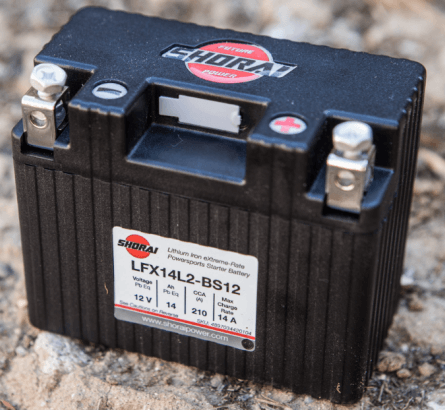
Figure 7: Shorai
Established in 2010, Shorai is a leader in lithium iron phosphate battery technology. Known for lightweight and long-lasting batteries, Shorai is a top choice for performance-focused riders. The brand offers a wide selection of batteries, ensuring compatibility with many motorcycle models. Shorai's commitment to innovation is evident in its continuous product development, aimed at enhancing battery performance and lifespan for a diverse range of Powersports enthusiasts.
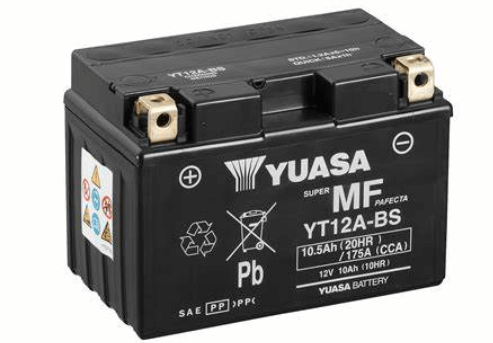
Figure 8: Yuasa
Yuasa, part of the Japan-based GS Yuasa legacy, has been influential in the American battery market since 1979. Specializing in batteries for motorcycles, ATVs, and snowmobiles, Yuasa is renowned for reliable products designed for various conditions. Blending traditional craftsmanship with modern innovation, Yuasa offers a range of highly regarded batteries known for their quality and resilience. With a broad network and deep industry knowledge, Yuasa remains a trusted name in battery technology, celebrated for robust and durable products.
Conclusion
Selecting the right battery for Powersports and motorcycle applications is a serious decision that affects the efficiency, safety, and performance of the vehicle. Through the detailed analysis of various battery types, from traditional flooded batteries to advanced lithium models, it is evident that each type offers distinct advantages and challenges. The choice of a suitable battery should be based on a thorough analysis of the vehicle’s requirements, environmental conditions, and the rider's expectations. As we navigate through the complexities of battery specifications, including dimensions, CCA, and capacity, it becomes clear that a well-informed choice can knowingly enhance the riding experience.
In addition, implementing robust care and maintenance strategies is requisite for prolonging battery life and ensuring consistent performance. Ultimately, whether opting for the rugged endurance of Odyssey batteries, the innovative technology of Shorai, or the reliable performance of Yuasa, the selection process must prioritize compatibility, performance requirements, and personal preferences to achieve the best possible outcome for both the rider and the machine.
Frequently Asked Questions [FAQ]
Q1. Are ATV and motorcycle batteries the same?
ATV and motorcycle batteries often share similar characteristics, but they are not automatically identical. Both types of vehicles typically use lead-acid or lithium-ion batteries, but their capacity and size can vary depending on the specific requirements of the vehicle. ATVs might need batteries with higher durability to handle off-road conditions, while motorcycles might prioritize compact and lightweight batteries for better performance.
Q2. What type of battery is a Powersports battery?
A Powersports battery is designed for vehicles like motorcycles, ATVs, snowmobiles, and personal watercraft. These batteries are built to withstand harsh conditions, vibrations, and temperature fluctuations. Commonly, they are either conventional lead-acid batteries, which may require maintenance like fluid top-ups, or sealed versions like AGM (Absorbent Glass Mat) and gel batteries, which are maintenance-free and offer improved reliability and longevity.
Q3. What's the best type of battery for a motorcycle?
The best type of motorcycle battery generally depends on the rider’s needs, but AGM batteries are often recommended. They are maintenance-free, spill-proof, and have good vibration resistance, making them ideal for motorcycles. They provide a reliable start-up and can handle frequent engine starts and stops better than traditional flooded batteries.
Q4. Which motorcycle battery lasts the longest?
Lithium-ion batteries are typically the longest-lasting for motorcycles. They are lighter than lead-acid batteries and have a lower self-discharge rate, meaning they hold a charge longer when not in use. In addition, lithium-ion batteries can handle more charge cycles, offering greater longevity and reliability over time.
Q5. How many volts should a good ATV battery have?
A good ATV battery should typically have a voltage of 12 volts. This is standard for the majority of ATVs, providing adequate power for starting the engine and supporting the electrical systems. It’s required to check the ATV’s specific requirements, as some models may have different needs, but 12 volts is generally standard.